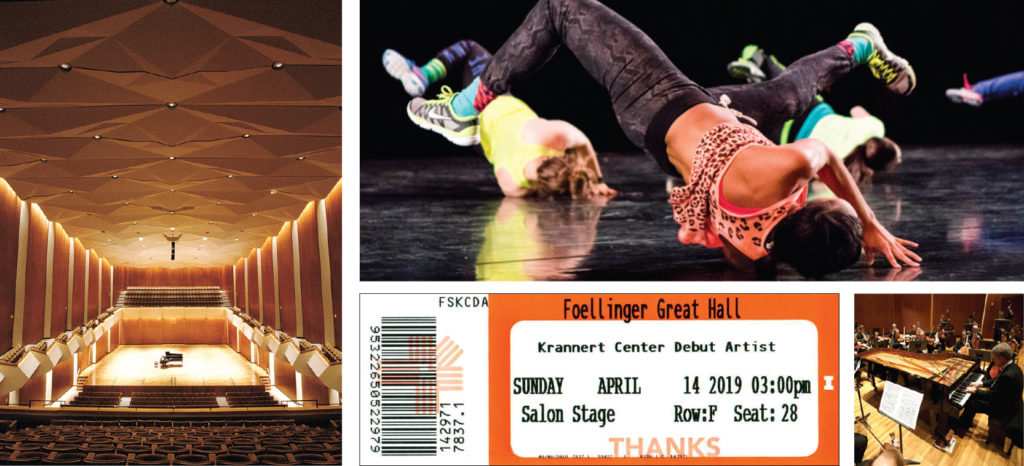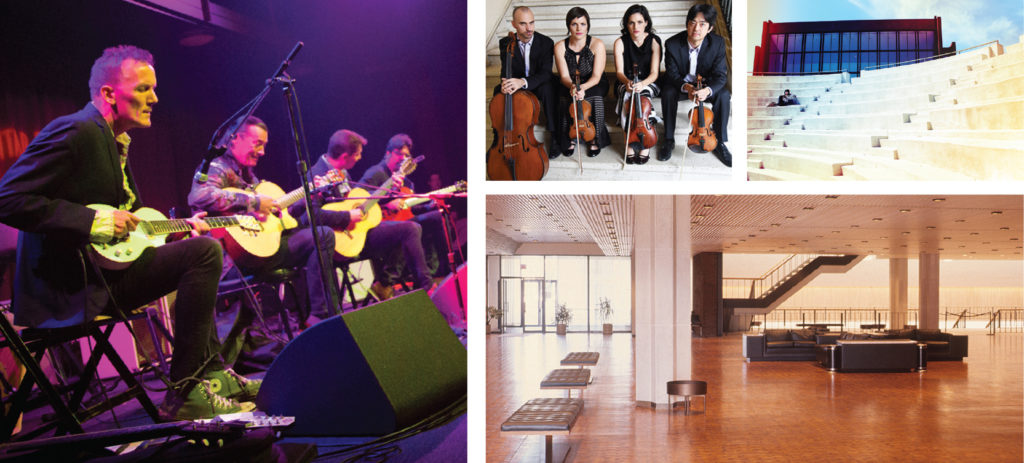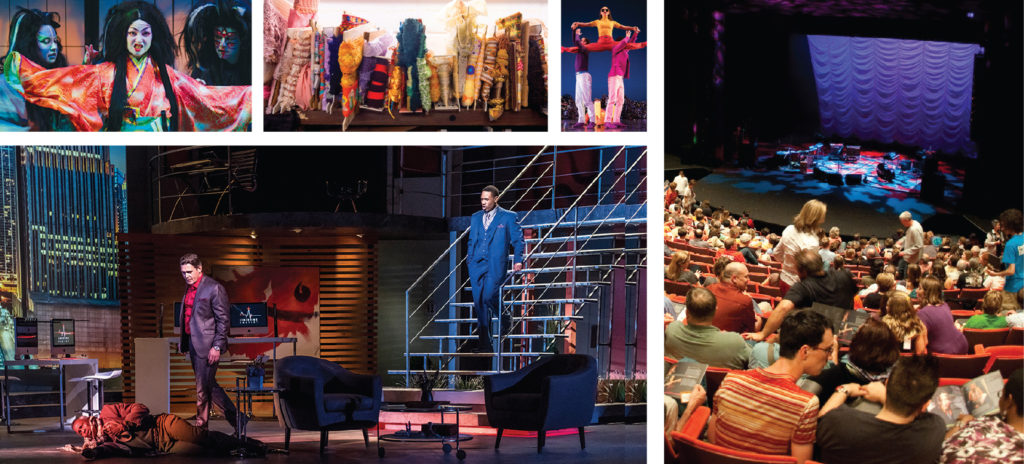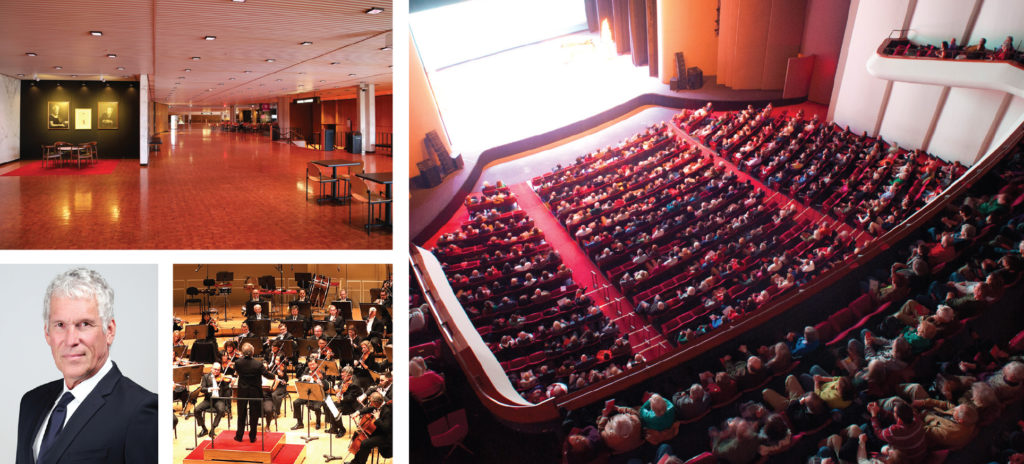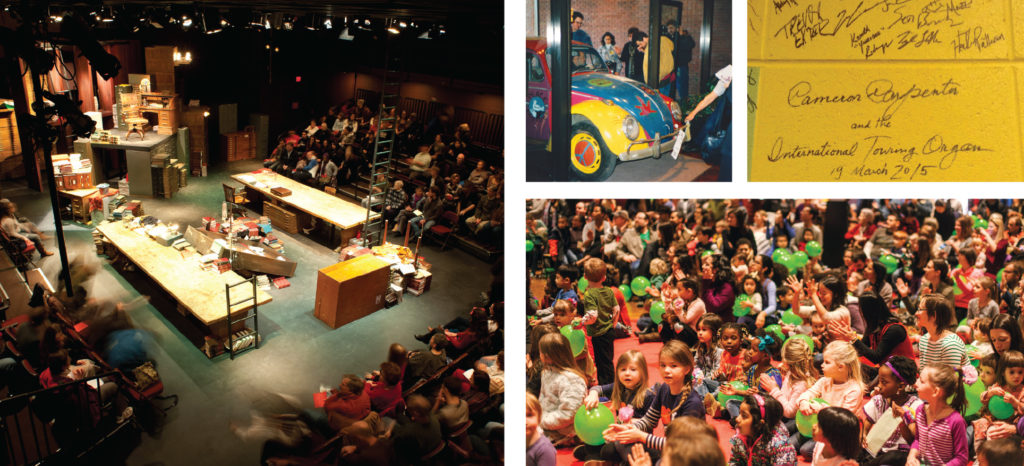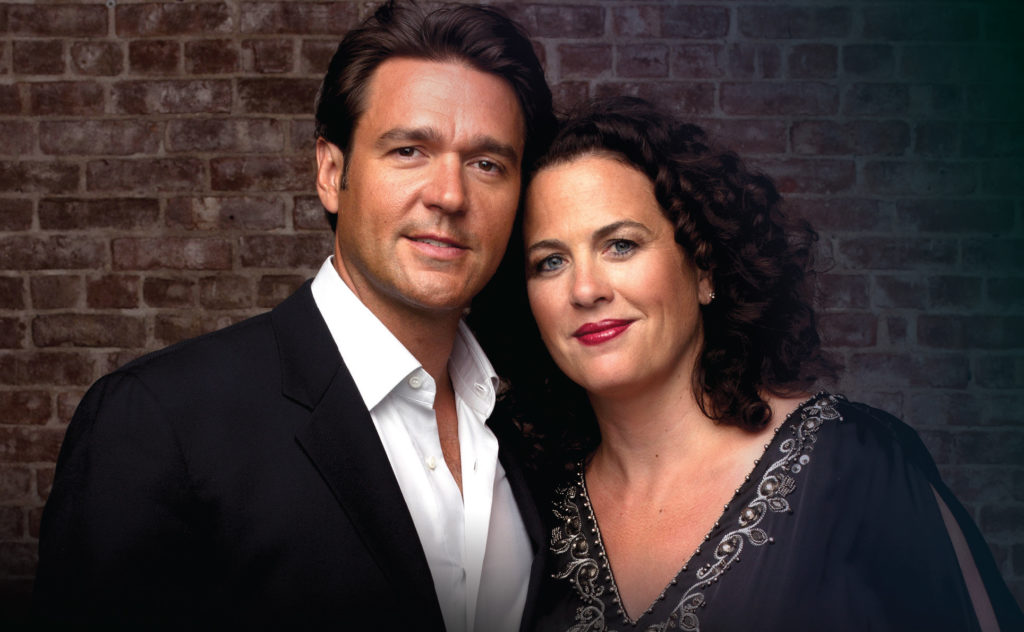Encore!
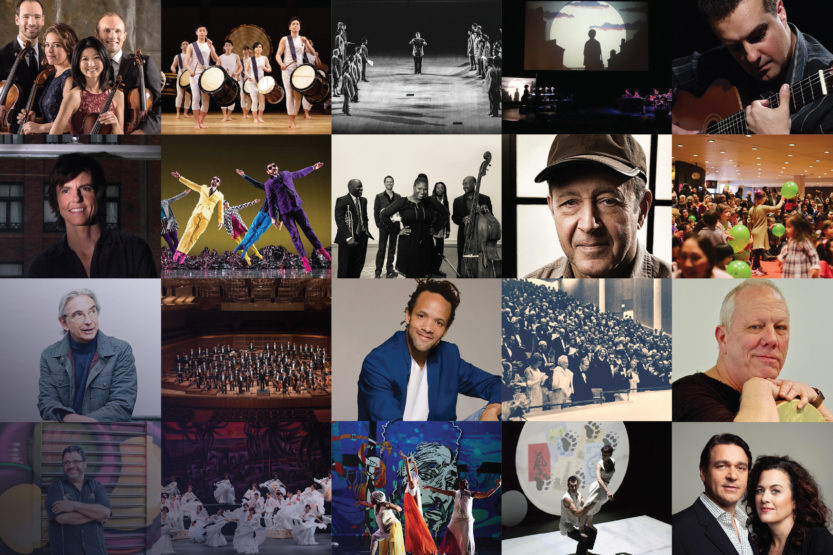 Images courtesy of KCPA.
Images courtesy of KCPA. A half-century ago, the Krannert Center for the Performing Arts opened as a facility of unprecedented scale and design for any educational institution anywhere. In the coming two seasons, the U of I’s remarkable complex will celebrate its 50 years as an outstanding venue for performance, instruction and outreach. What follows is a free-ranging look at the shows, facilities, artists, faculty, students, staff and stories that make KCPA great. Here’s looking at you, Krannert Center.
Krannert Center to the Letter
An alphabetical compendium of much that is marvelous about the U of I’s performing arts center
A is for the acoustic perfection synonymous with Foellinger Great Hall, acknowledged as one of the finest concert spaces in the world. Architect Max Abramovitz, whose design for New York’s Avery Fisher Hall had proved fashion-forward but acoustically challenged, collaborated with acoustics expert Cyril Harris to produce optimal warmth and sound diffusion in this elegant, deceptively narrow space, which seats more than 2,000. A suspended plaster ceiling, wooden walls and floor, and noise-absorbing plush seats—as well as a heating and cooling plant whose operational sounds were located across the street—yield acoustic warmth so profound and accommodating that the Great Hall “daylights” as a recording studio from which thousands of recordings have emerged over the years.
B is for bargain—of the student variety. Tickets for $15 (or less) are available to students for any Krannert Center performance, thanks to a policy instituted by KCPA Director Mike Ross. Such culture-friendly pricing ensures that as many undergraduate and graduate students as possible enjoy seats for the world-class concerts, plays, recitals, dance, films and other programs that fill the Krannert Center seasons. Get ’em while you can, kids—the chance to experience the world’s best artists and performances will never come this cheap again.
C is for Sinfonia da Camera and the Champaign Urbana Symphony Orchestra. The latter is KCPA’s resident orchestra, while the former is its professional chamber orchestra in residence. It numbers around 50 UI students, faculty and staff, and is now in its 34th year. Led by long-time director and pianist Ian Hobson, the Sinfonia will play six engagements in the 2018-19 season, including the Gilbert and Sullivan classic The Pirates of Penzance. Through its community outreach, the Sinfonia sponsors an annual Youth Concerto Competition.
D is for the two departments that call KCPA home—theatre and dance. Both were born around the same time as KCPA (theatre celebrated its 50th last March and dance will do so in February 2019), and each sprang from very different origins at Illinois (theater as a major in the LAS communications department and dance in kinesiology). The Center brought both to new levels, literally, offering space for faculty offices and studio instruction. The departments also found a new academic home in the College of Fine and Applied Arts, alongside the School of Music.
E is for ELLNORA, the biennual guitar extravaganza named in honor of the beloved Mrs. Krannert, who, with husband Herman, endowed KCPA. (See “Meeting of the Minds.”) Launched as the Wall to Wall Guitar Festival and renamed in 2010, the three-day, multi-genre, every-other-September event attracts dozens of performers and thousands of listeners. With past headliners including Buddy Guy, Lucinda Williams and Taj Mahal, watch for an announcement of bookings for ELLNORA 2019. Meanwhile, guitarist Marcus Tardelli will mark the festival’s spot on the calendar this year with an Oct. 3 ELLNORA Reverb concert.
F is for Friday, as in Friday, Sept. 7, 2018, opening night for KCPA’s two seasons of golden anniversary celebrations. Lighting a Catherine-wheel fireworks of performances and festivities that will spin into the spring of 2020, the opening party promises a lively musical lineup, a vintage car display and refreshments. The party is free and open to the public, and guests are encouraged to dress in the style of their decade of choice from the ’60s forward. Paisley and bell-bottoms, anyone?
G is for the Greek antecedent of UI’s outdoor Amphitheatre, designed by architect Max Abramovitz as KCPA’s fifth performance space. An austere semi-circle of steeply mounted white blocks set below the soaring glass windows of the Great Hall, the Amphitheatre dramatically evokes theater’s ancient beginnings, and is visible as one approaches from the Quad. Performances in this space, which holds an audience of 560, are rare and special. It’s enduringly popular with students for sunbathing, studying or meeting up for a first date.
H is for home, as in Come Home to Krannert Center. The weekend of April 12-14, 2019, will find artists, alumni and admirers of the Center gathering for three days of concerts, presentations and, of course, parties. Yes, there’s no place like home—especially when it’s a world-class home. “Our hope is that former staff and faculty and students, former patrons, artists and people for whom Krannert Center has been meaningful in their lives will be able to return to Champaign-Urbana,” says KCPA Director Mike Ross. “We are planning a glorious reunion and celebration.” Watch for details about the event, which heralds the 50th anniversary of KCPA’s opening festivities on April 19-20, 1969.
I is for intermission, taking place as it does, in a 1.5-acre lobby that can hold up to 4,000 people. When constructed in 1968, the parquet floor required the entire supply of teak available for import into the U.S. that year. The lobby has effortlessly accommodated the later additions of the Intermezzo café, the Promenade showcase and gift shop, and Stage 5, a venue and bar for free concerts.
J is for the Jupiter String Quartet, KCPA’s house band—if renditions of Beethoven, Bartok and Britten may be thought of as house music. The award-winning ensemble in residence joined the UI School of Music faculty in 2012, and its members offer courses and individual instruction in chamber music. The four appear at KCPA at least three times a year and tour throughout the Americas and Europe. The quartet takes its name from the planet Jupiter, whose astrological symbol resembles the numeral four.
K is for Western Kabuki, an international theater fusion conjured by Shozo Sato, a longtime professor of art and design at Illinois, who performed at the opening of KCPA in April 1969. Sato went on to win international acclaim in 1978 for his Kabuki Macbeth, melding the Japanese theater tradition with Shakespeare. Kabuki Madame Butterfly, Medea, Mikado, Achilles and Othello followed at the Center and in venues worldwide.
L is for Level 2 in the Center, a veritable village of costume and scene shops, a paint room, an audio center, rehearsal spaces, stage entrances, offices, bulletin boards and tunnels. Oh, and the loading dock, where KCPA occasionally hosts staff gatherings. The ingenuity of the design is apparent in this hive of work and (literal) play, which connects to all four performing spaces.
“[Krannert Center is] one of the most ingeniously worked out art complexes anywhere.” —The New York Times
M is for the Mark Morris Dance Group, a New York company that calls KCPA its Midwestern home. Renowned for its innovative choreography, the company has formed deep ties, not only to the University, but to the local community, collaborating on the Dance for People with Parkinson’s program and offering family fun classes during its annual campus residency.
N is for nexus, the role that KC- PA itself plays both as a prestigious venue for some of the world’s finest actors, singers, musicians, dancers, acrobats, puppeteers and other performers, and as an instructional space to nurture the artists and audiences of the future. This role is a glittering light in the brilliant network of excellence and exploration that is the University of Illinois.
“Artists feel safe to try things—and sometimes fail—because we have an audience that understands it’s a Tier 1 research institution—we’re doing research. And Krannert is unique in that way among all performing arts facilities.” —Nathan Gunn, baritone, UI Professor of Voice
O is for the operatic ethos of Lyric Theatre @ Illinois, a UI School of Music program for nascent divas and future musical theater stars. Offering graduate and undergraduate degrees, the program teaches singing for the stage in a range of styles, and is rich in performance opportunities, including three fully staged musical and opera productions annually. Co-director of the Lyric since 2013, acclaimed baritone Nathan Gunn, ’94 FAA, made his directorial debut in February with a production of Don Giovanni, in which he also sang the title role. Gunn gave the production a very 21st century spin, transforming Giovanni from a seducer into a corporate raider.
P is for Krannert Center’s Colwell Playhouse. So beautiful is this setting—crescents of red seats outlined by dark walls and floor—that when viewed from above, it evokes a CGI template for a video game. The elegant continental seating has extra-wide rows, no center aisles and 600-plus seats, creating an intimate setting particularly designed for the spoken word.
Q is for quiet, a curious term for a performing arts center where expression is all. But “quiet” is the word. From the prairie colors and elegant concourses of glass, stone, brick, marble and wood to the conspicuous absence of staircased and chandeliered grandeur, the décor has endured through time. “Quiet” also applies to the Center’s sound, wrapped in layers of engineering and delivered to audiences in peak condition.
R is for Mike Ross. Director of KCPA since 1997, Ross has taken the Center in exciting directions, including more synergy with UI academic units, community engagement, and championing free speech and artistic expression. “I continue to be invigorated by the Center’s mission.”
S is for the Chicago Symphony Orchestra, which has played KCPA 36 times—more than any other off-campus artist or ensemble—since its first concert date at UI in 1973. Happily, campus is an easy two-and-a half-hours south from the Windy City. The CSO’s 37th KCPA concert will include works by Berlioz and Chopin.
T is for KCPA’s Tryon Festival Theatre. No wall parallels any other wall here, creating an arrangement that invites sound to travel easily from the stage to the last row in the, nearly 1,000-seat house. This venue has hosted operas, plays, ballets, musicals, concerts, puppets, acrobats and comedians over the years, including the annual holiday ballet, The Nutcracker.
U is for Illinois undergraduates, with whom KCPA connects in many ways. Foremost is the first-class instruction in music, dance and acting that students receive, along with opportunities to take the stage in the Center’s peerless performance spaces. Students also work at KCPA as support staff and members of the Krannert Center Student Association who usher and advocate for the Center. And Krannert Center Ambassadors connect their fellow students to KCPA through marketing and promotion.
“[Krannert is] where I started devouring Western drama, which laid the foundation of what I do today. It changed my life.” —Ang Lee, filmmaker
V is for the Volkswagen Beetle that enjoyed a brief artistic residence at the Center 25 years ago. As part of its silver anniversary celebration in 1994, KCPA threw a party where the ’60s-style decorations included the car, which had been taken apart and reassembled for its “engagement” in the Studio Theatre. It was one of two known appearances by a motor vehicle in that space. The second took place in the fall of 2014, when cadets from Lincoln’s Challenge Academy muscled a red four-door sedan into the Studio Theatre. After the removal of its doors and a new “distressed” paint job, the vehicle played a strong (but silent) role in a production of the play, Polaroid Stories.
W is for the “signing wall,” a stretch of painted concrete block along the main corridor through Level 2 (see “L”). Artists who perform at KCPA are invited to autograph the blocks and hundreds have obliged in a Sharpie-enabled proliferation of printing, cursive, scrawls, self-caricatures, stencils and line drawings of musical instruments. The wall bears signatures of performers from Joshua Bell to Dweezil Zappa. In several languages and in many ways, the messages all carry the same thought: Thanks for the chance to perform for this wonderful community in this great space.
X is for the “X” in box, as in “black box,” as in the Studio Theatre. With every component moveable in this compact performing space—from stage and seats to curtains and lighting—Schrödinger’s cat has nothing on the possibilities here. But that’s what directors are for and many have willingly met the challenge of suiting the physical environment to match their vision. Painted brown and seating up to 200, the theater has exits on four corners—three more than the box that held the sometimes-unfortunate feline. An intense setting for smaller scale and club-style plays, the Studio Theatre has also hosted experimental and avant-garde productions.
Y is for Krannert’s Youth Series, a living foray into the intersection between arts and community. Now in its 36th year, the program provides low-cost tickets to school groups, allowing teachers to treat students to top-notch performances of music, theater and dance. The series has brought more than 350,000 students—from pre-kindergarten kids to high schoolers—to the Center.
Z is for KCPA as the zenith of such centers, described by Director Mike Ross as “an ecosystem for the performing arts. This facility inspires people all the time,” he says. “We hear it from faculty and students. We hear it from artists from all over the world. We hear it from audience members. We hear it from University guests who never imagined that such a place would exist in the heartland, in a population center of this size. Krannert Center inspires people all the time. And I believe it helps people to sustain hope.”
“[The facility] inspires people all the time … and I believe it helps people to sustain hope.” —Mike Ross, Krannert Center director
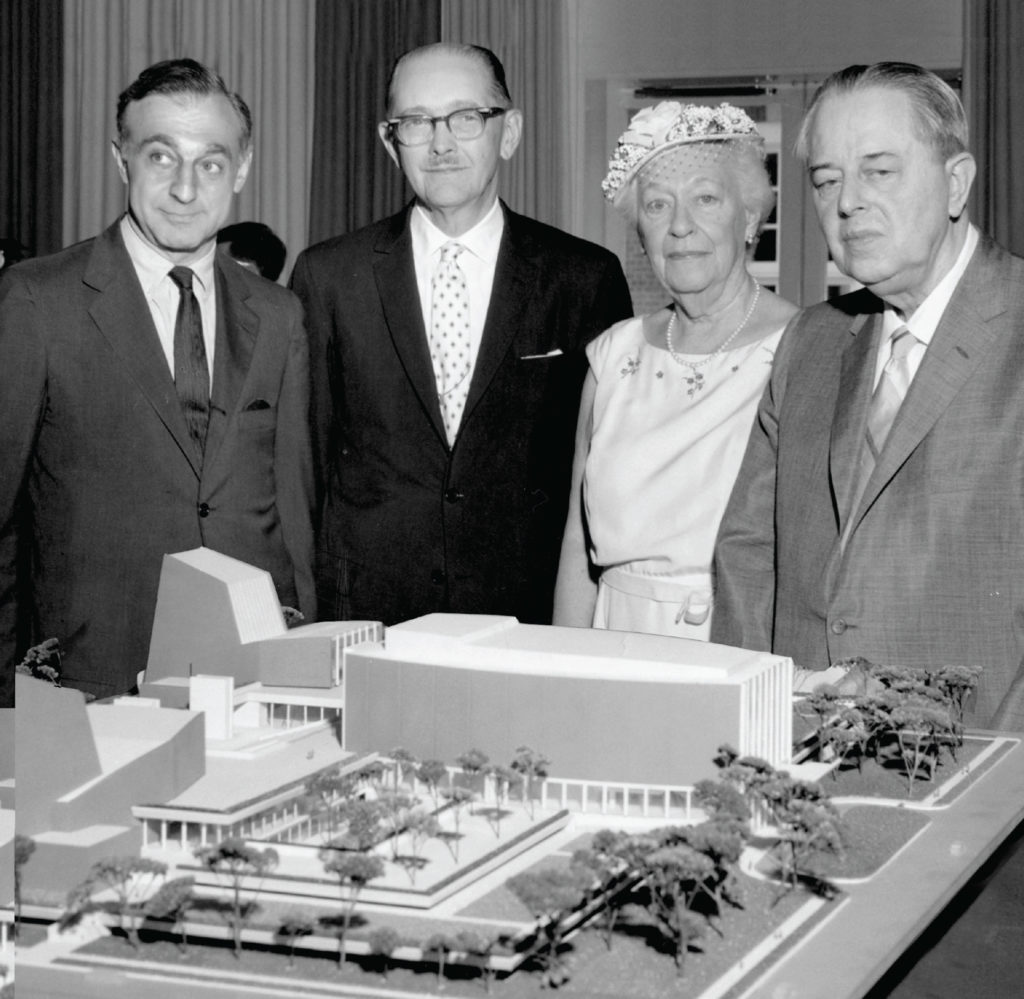
Left to right, architect Max Abramovitz, UI President David Dodds Henry and donors Ellnora and Herman Krannert in 1964 with a model of the performing arts center they helped to create. Both Abramovitz and Herman Krannert were among the first to receive the Illinois Alumni Achievement Award, presented in 1960 and 1963 respectively, well before the extraordinary construction of Krannert Center. Image courtesy of KCPA.
Meeting of the Minds
How the generosity of one Illinois alumnus and the architectural vision of another birthed a performance center like no other
They were a gracious couple from Indiana with a passion for philanthropy and a fondness for education and the arts. Fortune had smiled on his hard work and so Herman, 1912 ENG, and Ellnora Krannert smiled together on their home in the Midwest, supporting a range of public endeavors so generously as to approach extravagance. And without them, one of the world’s finest performing arts centers might never have come to be.
In the fall of 1962, the Krannerts approached the University of Illinois with a wish to make a major gift. Notwithstanding the gem of an art museum already bearing their name, which had opened the previous year on the south end of the Illinois campus (as well as a host of other facilities at educational institutions, hospitals and a research institute in Indiana)—the couple felt compelled to do more.
But as to what “more” meant, they wanted to talk. Grateful to the University for the engineering education that had propelled Herman from a deprived Chicago childhood to extraordinary success as founder and leader of Inland Container Corp., an Indiana manufacturer of corrugated boxes, they came to the table looking for guidance on how to (yet again) make a difference.
“We have only provided the bricks and mortar, but it’s the people that count.” —Herman Krannert
UI President David Henry offered a range of ideas. But it was the vision of a center for the performing arts—one that would attract thespians, musicians, dancers and singers and allow students to learn, practice and perform under the guidance of gifted faculty—that most impressed the Krannerts. In December of 1962, Herman sent a letter to Henry committing $16 million for a performing arts center. When construction bids came in higher, he immediately pledged $5 million more, with the University covering the cost of the parking garages. The final cost would come in at $26 million—estimated at $300 million in 2018 replacement value.
Committed not simply to philanthropy but to the transformation that philanthropy can support, the Krannerts worked with Max Abramovitz, ’29 FAA, on the Center’s design and construction. Abramovitz—who, like Herman, attended Crane Technical High School in Chicago—had already transfigured the UI campus with Assembly Hall, the space-ship-shaped, paper-white, concrete-domed arena now known as State Farm Center. Viewing the Krannert Center assignment as the foremost challenge of his career, Abramovitz began by envisioning a unique facility, laid out with four performance spaces and stacked with underground levels accommodating instruction, rehearsal and production.
The Krannerts approved Abramovitz’s architectural plans in 1964. As they worked together, Ellnora famously asked for a big lobby because, she told Abramovitz, she was tired of Broadway theaters so pressed for space that audience members had to spend intermissions outside on the curb. Abramovitz obliged her with 1.5 acres of lobby space. The Great Hall’s handsome and acoustically friendly plaster ceiling also was created at her request. As to Herman’s input, generations of Krannert Center-goers have him to thank for his suggestions for capacious underground parking and extensive outdoor lights, both of which have proved welcome, especially on many blustery, snowy Midwestern nights in winter seasons since.
When the Krannert Center for the Performing Arts opened five years later with a month of festivities in the spring of 1969, it immediately won accolades as one of the world’s finest facilities of its kind. Fifty years later, its allure, elegance and performance-friendliness endure. The Center remains uncommon in its instructionally centered design and continues to be acknowledged as one of the finest performing arts facilities on any campus anywhere in the world.
“We have only provided the bricks and mortar, but it’s the people that count—the people who work in the Center, the people who come to the performances,” Herman told this publication. “The Center is for people. That’s what Mrs. Krannert and I want.” —M.T.
Top Gunns
Music icons tour for Krannert Center
It’s a big, big, big world beyond campus and Nathan, ’94 FAA, and Julie, MMUS ’92, AMUSD ’01, Gunn are very much its citizens. In their allied careers—he a fabled opera star, she a gifted pianist—they have roamed the globe with stops in such famous venues as Carnegie Hall, the Paris Opera and the Royal Opera and in performances with partners as diverse as the London Symphony, Mandy Patinkin and Cafe Carlyle Cabaret.
In 2007, the two came home to campus and Krannert Center, where they had developed and polished their talents and met while students in the UI School of Music. Now the parents of five children, they both hold SOM faculty appointments, including leadership roles in Lyric Theatre @ Illinois, a vocal-performance degree program. But teaching and family responsibilities have not sidelined a rigorous touring schedule, particularly for Nathan. The critically acclaimed and popularly beloved baritone has sung numerous engagements in 2017/2018 alone.
Over the next few years, the two will be going out into the world for a different purpose—as advocates for the future of the performing arts center that launched them to international success. The Gunns are serving as the faces of Endow the Dream, a five-year, $30 million campaign to take KCPA to a new level of support for top-notch programming, resource-rich education, cutting-edge research and expanded access and public engagement.
“I would like to see $300 million raised to bring this facility into the 21st century so that we can do creative work with virtual reality, have a studio where we can engage more kids, and make it a destination for people who come to campus, much like Millennium Park in Chicago, where everyone wants to go to ‘The Bean.’” —Nathan Gunn
“I want to actually endow the dream that Herman Krannert had,” says Nathan. “I would like to see $300 million raised to bring this facility into the 21st century so that we can do creative work with virtual reality, have a studio where we can engage more kids, and make it a destination for people who come to campus, much like Millennium Park in Chicago, where everyone wants to go to ‘The Bean.’ This should be a place where people gather.”
The couple will be sharing stories about the Center and envisioning its future at get-togethers with alumni who, like themselves, studied at Krannert Center, and artists who, also like themselves, have performed there. Many such alumni, artists and supporters can be found around the country and the world. The Center’s constellation of connections, which enhances the arts globally and attracts artists to campus, has come to be called “The Krannert Effect.” “It’s like one of those maps—‘Where United Flies,’” Julie says. “I can see it in my head.”
Nathan adds: “We hope to shine a light on the graduates from this campus over the past 50 years who have enjoyed what goes on here at Krannert Center—and others around the country and the world who have enjoyed what has been incubated here, so that they recognize this jewel of a performing arts facility. It doesn’t exist anywhere else.”—M.T.

